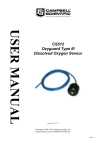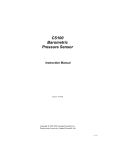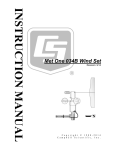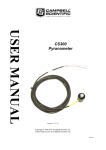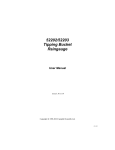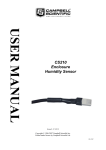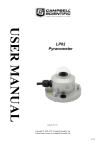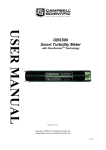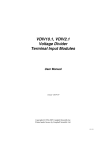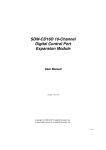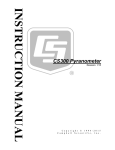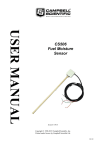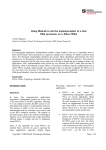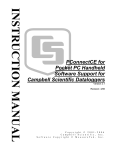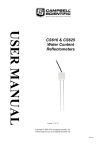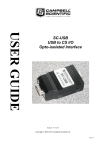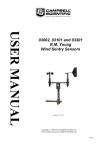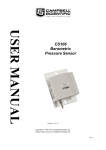Download CS511-L Sensorex Dissolved Oxygen Probe
Transcript
CS511-L Sensorex Dissolved Oxygen Probe User Manual Issued 18.3.13 Copyright © 2001-2013 Campbell Scientific Inc. Printed under licence by Campbell Scientific Ltd. CSL 560 Guarantee This equipment is guaranteed against defects in materials and workmanship. This guarantee applies for twelve months from date of delivery. We will repair or replace products which prove to be defective during the guarantee period provided they are returned to us prepaid. The guarantee will not apply to: • Equipment which has been modified or altered in any way without the written permission of Campbell Scientific • Batteries • Any product which has been subjected to misuse, neglect, acts of God or damage in transit. Campbell Scientific will return guaranteed equipment by surface carrier prepaid. Campbell Scientific will not reimburse the claimant for costs incurred in removing and/or reinstalling equipment. This guarantee and the Company’s obligation thereunder is in lieu of all other guarantees, expressed or implied, including those of suitability and fitness for a particular purpose. Campbell Scientific is not liable for consequential damage. Please inform us before returning equipment and obtain a Repair Reference Number whether the repair is under guarantee or not. Please state the faults as clearly as possible, and if the product is out of the guarantee period it should be accompanied by a purchase order. Quotations for repairs can be given on request. It is the policy of Campbell Scientific to protect the health of its employees and provide a safe working environment, in support of this policy a “Declaration of Hazardous Material and Decontamination” form will be issued for completion. When returning equipment, the Repair Reference Number must be clearly marked on the outside of the package. Complete the “Declaration of Hazardous Material and Decontamination” form and ensure a completed copy is returned with your goods. Please note your Repair may not be processed if you do not include a copy of this form and Campbell Scientific Ltd reserves the right to return goods at the customers’ expense. Note that goods sent air freight are subject to Customs clearance fees which Campbell Scientific will charge to customers. In many cases, these charges are greater than the cost of the repair. Campbell Scientific Ltd, Campbell Park, 80 Hathern Road, Shepshed, Loughborough, LE12 9GX, UK Tel: +44 (0) 1509 601141 Fax: +44 (0) 1509 601091 Email: [email protected] www.campbellsci.co.uk PLEASE READ FIRST About this manual Please note that this manual was originally produced by Campbell Scientific Inc. primarily for the North American market. Some spellings, weights and measures may reflect this origin. Some useful conversion factors: Area: 1 in2 (square inch) = 645 mm2 Length: 1 in. (inch) = 25.4 mm 1 ft (foot) = 304.8 mm 1 yard = 0.914 m 1 mile = 1.609 km Mass: 1 oz. (ounce) = 28.35 g 1 lb (pound weight) = 0.454 kg Pressure: 1 psi (lb/in2) = 68.95 mb Volume: 1 UK pint = 568.3 ml 1 UK gallon = 4.546 litres 1 US gallon = 3.785 litres In addition, while most of the information in the manual is correct for all countries, certain information is specific to the North American market and so may not be applicable to European users. Differences include the U.S standard external power supply details where some information (for example the AC transformer input voltage) will not be applicable for British/European use. Please note, however, that when a power supply adapter is ordered it will be suitable for use in your country. Reference to some radio transmitters, digital cell phones and aerials may also not be applicable according to your locality. Some brackets, shields and enclosure options, including wiring, are not sold as standard items in the European market; in some cases alternatives are offered. Details of the alternatives will be covered in separate manuals. Part numbers prefixed with a “#” symbol are special order parts for use with non-EU variants or for special installations. Please quote the full part number with the # when ordering. Recycling information At the end of this product’s life it should not be put in commercial or domestic refuse but sent for recycling. Any batteries contained within the product or used during the products life should be removed from the product and also be sent to an appropriate recycling facility. Campbell Scientific Ltd can advise on the recycling of the equipment and in some cases arrange collection and the correct disposal of it, although charges may apply for some items or territories. For further advice or support, please contact Campbell Scientific Ltd, or your local agent. Campbell Scientific Ltd, Campbell Park, 80 Hathern Road, Shepshed, Loughborough, LE12 9GX, UK Tel: +44 (0) 1509 601141 Fax: +44 (0) 1509 601091 Email: [email protected] www.campbellsci.co.uk Contents PDF viewers: These page numbers refer to the printed version of this document. Use the PDF reader bookmarks tab for links to specific sections. 1. Introduction ................................................................. 1 2. Cautionary Statements............................................... 2 3. Initial Inspection ......................................................... 2 3.1 Shipping Kit and Accessories ................................................................ 2 3.1.1 Shipping Kit .................................................................................... 2 3.1.2 Optional Probe Accessories ............................................................ 2 4. Quickstart .................................................................... 3 4.1 4.2 4.3 Getting Probe Ready to Use................................................................... 3 Use SCWin to Program Datalogger and Generate Wiring Diagram .... 5 Mount Probe ........................................................................................... 8 5. Overview ...................................................................... 8 6. Specifications ............................................................. 9 7. Operation ................................................................... 11 7.1 7.2 Wiring ................................................................................................... 11 Programming ........................................................................................ 11 7.2.1 CRBasic ........................................................................................ 11 7.2.1.1 Example CR1000 Program Using VoltDiff ...................... 12 7.2.1.2 Example CR200(X) Program ............................................ 13 7.2.2 Edlog ............................................................................................. 13 7.2.2.1 Portion of CR10X Sample Program Using P1 .................. 14 7.2.2.2 Portion of CR10X Sample Program Using P2 .................. 14 7.3 Calibration ............................................................................................ 14 8. Maintenance .............................................................. 16 8.1 Cleaning Probe and Replacing the Membrane .................................... 16 i Appendices A. Dissolved Oxygen Tables ...................................... A-1 B. Sensorex’s Model DO6200/T .................................. B-1 B.1 B.2 DO6200/T Specifications...................................................................B-1 Accessories for DO6200/T ................................................................B-2 C. PT4-L Agitator ......................................................... C-1 C.1 C.2 C.3 Description .........................................................................................C-1 PT4-L Specifications..........................................................................C-2 Agitator Control .................................................................................C-2 1-1. 8-1. 8-2. 8-3. 8-4. 8-5. 8-6. B-1. C-1. C-2. C-3. The CS511-L is currently Sensorex’s DO6400/T (left). The DO6200/T (right) was shipped prior to June 2008 (refer to Appendix B). ......................................................................................1 Separate the lower body from the upper body.....................................16 Remove membrane and O-ring ............................................................17 Using a toothbrush to clean probe .......................................................18 Proper O-ring placement ......................................................................19 Installing membrane .............................................................................20 Check for leakage .................................................................................21 Sensorex’s model DO6200/T.............................................................B-1 Preventing Bio-fouling of a DO Sensor ............................................C-1 DO sensor with PT4 Agitator ............................................................C-2 Agitator Wiring ..................................................................................C-3 7-1. 7-2. 7-3. Sensor Wiring .......................................................................................11 Wiring for Example 1 ..........................................................................12 Wiring for Example 2 ..........................................................................13 Figures Tables ii CS511-L Dissolved Oxygen Probe 1. Introduction The CS511 is a rugged, low-maintenance sensor that is manufactured by Sensorex. It consists of a self-polarizing galvanic cell that generates a millivolt signal proportional to the amount of oxygen present in the measured medium (typically water). Before installing the CS511, please study • • • NOTE Section 2, Cautionary Statements Section 3, Initial Inspection Section 3.1, Quickstart Currently, the CS511 is Sensorex’s Model DO6400/T. Prior to June 2008, the CS511 was Sensorex’s Model DO6200/T. Programming, wiring, and most specifications are the same for these two sensors. However, they use different accessories and look different (see Figure 1-1). Refer to Appendix B if you have Sensorex’s Model DO6200/T. DO6200/T DO6400/T Figure 1-1. The CS511-L is currently Sensorex’s DO6400/T (left). The DO6200/T (right) was shipped prior to June 2008 (refer to Appendix B). 1 CS511-L Dissolved Oxygen Probe 2. 3. Cautionary Statements • The CS511 is a precision instrument. Please handle it with care. • Because the CS511 is shipped dry, electrolyte needs to be added before using the probe (see Section 4.1, Getting Probe Ready to Use). • Letting the CS511 dry up shortens the life of the membrane and probe. • Drain the solution from the CS511 before storing it out of water. • Replace the membrane and recalibrate the probe before redeploying the CS511 after it has been stored out of water or dried up in the field. Initial Inspection 3.1 • Upon receipt of the CS511, inspect the packaging and contents for damage. File damage claims with the shipping company. • Immediately check package contents against the shipping documentation (see Section 3.1, Shipping Kit and Accessories). Contact Campbell Scientific about any discrepancies. • The model number and cable length are printed on a label at the connection end of the cable. Check this information against the shipping documents to ensure the expected product and cable length are received. Shipping Kit and Accessories NOTE Except for the agitator, these items are for Sensorex’s DO6400/T. Refer to Appendix B if you have a DO6200/T. 3.1.1 Shipping Kit (1) Membrane replacement tool (1) Bottled DO electrolyte, 250 ml (2) Teflon membranes (2) Membrane O-rings (2) Membrane spaces 3.1.2 Optional Probe Accessories 2 • PT4─L Agitator with Repeat Cycle Timer for stagnant conditions (see Appendix C) • #22261 Maintenance Kit containing (5) Teflon membranes, (5) membrane O-rings, (5) tensioning washers, and a 250-ml bottle of electrolyte • #22262 Maintenance Kit containing (25) Teflon membranes, (25) membrane Orings, (25) tensioning washers, and a 500-ml bottle of electrolyte • #22263 Spare Parts Kit containing (2) membrane locks, (2) tensioning washers, (2) body O-rings, and (1) membrane-replacement tool User Manual 4. Quickstart Please review Section 7, Operation, for wiring, programming, and calibration information. 4.1 Getting Probe Ready to Use 1. 2. Unscrew the lower body from the upper body. Inspect the membrane for wrinkles. Replace membrane if wrinkled (see Section 8.1, Cleaning Probe and Replacing the Membrane). 3 CS511-L Dissolved Oxygen Probe 3. Pour clean water into the lower body and look for leakage around the membrane. Dispose of the water, and if there is leakage, replace membrane (see Section 8.1, Cleaning Probe and Replacing the Membrane). 4. Pour fresh electrolyte in the bottom cap and fill to the top of the cap. 5. Keep the probe upright with the cable pointed upwards (not sideways). Screw the bottom cap onto the upper body until hand tight. r W a te NOTE 4 Excess electrolyte will leak out at the joint between the probe’s cap and upper body. User Manual 4.2 Use SCWin to Program Datalogger and Generate Wiring Diagram The simplest method for programming the datalogger to measure the 034B is to use Campbell Scientific’s SCWin Program Generator. 1. Open Short Cut and click on New Program. 2. Select the datalogger and enter the scan interval. 5 CS511-L Dissolved Oxygen Probe 6 3. Select CS511 Dissolved Oxygen Probe, and select the right arrow (in centre of screen) to add it to the list of sensors to be measured, and then select Next. 4. Define the name of the public variables and enter the calibration multiplier. Variables default to DOmv for the millivolt measurements and DOppm for the ppm values. The default calibration value of 0.34 is based on an average. It is preferable to calibrate the probe using the procedure provided in Section 7.3, Calibration. After entering the information, click on OK, and then select Next. User Manual NOTE 5. Choose the outputs and then select Finish. 6. In the Save As window, enter an appropriate file name and select Save. 7. In the Confirm window, click Yes to download the program to the datalogger. 8. Click on Wiring Diagram and wire according to the wiring diagram generated by SCWin Short Cut. Campbell Scientific also recommends connecting the shield wire to ground. 7 CS511-L Dissolved Oxygen Probe 4.3 Mount Probe Mount the CS511 in water at a slight angle, which prevents bubbles from becoming trapped on the membrane. 5. Overview The CS511 is a galvanic probe which produces a millivolt signal proportional to the amount of oxygen present in the measured medium. Oxygen diffuses through the membrane onto the cathode, reacts chemically, and combines with the anode. An electrical current is produced by this chemical reaction which is converted from microamps to millivolts by an in-line resistor. An in-line thermistor also conditions the signal providing automatic temperature compensation. With these features, the probe produces a linear, millivolt output proportional to the oxygen present in the medium in which it is placed. The probe consists of two parts, an upper part with cathode, anode, and cable, and a lower part comprising of a screw-on membrane cap. The probe is shipped dry, but has a membrane installed in the cap. With the membrane in place, the cap must be filled with electrolyte solution before the cap is screwed onto the top component. The probe is self-polarizing and requires no external power source. The probe's robust construction and simple design make maintenance and servicing it straightforward. There is no need to send the probe back to the factory for 8 User Manual servicing. It uses a strong, easy-to-clean, and easy-to-change membrane in a screwon membrane cap. Regular servicing is not required. When necessary, the probe can be fully overhauled in five min. The CS511’s cable can terminate in: • • 6. Connector that attaches to a prewired enclosure (option –PW). Refer to www.campbellsci.com/prewired-enclosures for more information. Connector that attaches to a CWS900 Wireless Sensor Interface (option – CWS). The CWS900 allows the probe to be used in a wireless sensor network. Refer to www.campbellsci.com/cws900 for more information. Specifications Features: • In-line thermistor provides automatic temperature compensation • Agitator available that keeps the probe clean and moves water across membrane for more accurate readings • Compatible with all Campbell Scientific dataloggers Compatible Dataloggers: CR200(X)-series CR800 series CR1000 CR3000 CR5000 CR9000X CR510 CR10(X) CR23X CR7 21X Principle of Measurement: Membrane-covered, galvanic oxygen probe Output Signal: 33 mV ± 9 mV (100% saturation), < 2 mV (0% saturation) Accuracy: Better than ± 2% of reading ± 1 digit when calibration temperature equals measuring temperature ± 5°C Response Time: 5 min. from 100% to 0% oxygen Materials of Construction: Body: Anode: Cathode: Noryl Silver Zinc Diameter: 5.72 cm (2.25 in) Height: 17.78 cm (7 in) from bottom of sensor to end of cable-strain relief Shipping Weight 0.8 kg (1.75 lb) Cable Jacket Material: PVC Operating Conditions: Temperature Pressure: Minimum Submersion Depth: 0° to 50°C (32° to 122°F) 0 to 100 psig 60 mm (2.5 in) 9 CS511-L Dissolved Oxygen Probe Minimum Water Flow: 5 cm/s (2 in/sec) across membrane Calibration: In air or in air saturated water Temperature Compensation: Automatic from 4° to 40°C (40° to 104°F) Range of Dissolved Oxygen: 0.5 to 50 ppm Probe Electrolyte: NaCl + glycerol (prevents freezing) red wire (+) black wire (-) black waterproof cable (10ft length standard) flexible cable strain relief Noryl Body 0.99” 7.00" (25.1mm) (177.8mm) 2.25” (57.2mm) 10 User Manual 7. Operation 7.1 Wiring The CS511 can use one differential channel or one single-ended channel. Differential wiring is better at rejecting electrical noise and ground loop error. Table 7-1. Sensor Wiring 7.2 CR510, CR10X, CR800, CR850, CR23X, CR1000, CR3000, CR5000 CR200(X)-Series Colour Function White Signal + Differential High, or Single-Ended Channel Single-Ended Channel Black Signal - Differential Low or AG Ground Clear Shield Ground Ground Programming NOTE This section describes using CRBasic or Edlog to program the datalogger. See Section 4.2, Use SCWin to Program Datalogger and Generate Wiring Diagram, if using Short Cut. Dataloggers that use CRBasic include the CR200(X)-series, CR800, CR850, CR1000, CR3000, and CR5000. Dataloggers that use Edlog include the CR510, CR10X, and CR23X. CRBasic and Edlog are included with LoggerNet and PC400 software. 7.2.1 CRBasic In the CR800, CR850, CR1000, CR3000, and CR5000, VoltDiff() or VoltSE() can be used to measure the CS511. In the CR200(X)-series dataloggers, only the VoltSE() instruction can be used since these dataloggers do not support differential measurements. Example programs are provided in Section 7.2.1.1, Example CR1000 Program Using VoltDiff, and Section 7.2.1.2, Example CR200(X) Program. 11 CS511-L Dissolved Oxygen Probe 7.2.1.1 Example CR1000 Program Using VoltDiff This example is a CR1000 program but programming for the CR800, CR850, CR3000, and CR5000 is similar. Table 7-2 shows the wiring for the example. Table 7-2. Wiring for CR1000 Example CR1000 Connection Sensor Wire 1H White 1L Black Ground Clear 'CR1000 'Declare Variables and Units Public Batt_Volt Public DOmV Public DOppm Units Batt_Volt=Volts Units DOmV=mV Units DOppm=ppm 'Define Data Tables DataTable(Table1,True,-1) DataInterval(0,60,Min,10) Sample(1,DOmV,FP2) Sample(1,DOppm,FP2) Sample(1,Batt_Volt,FP2) EndTable DataTable(Table2,True,-1) DataInterval(0,1440,Min,10) Minimum(1,Batt_Volt,FP2,False,False) EndTable 'Main Program BeginProg Scan(5,Sec,1,0) 'Default Datalogger Battery Voltage measurement Batt_Volt: Battery(Batt_Volt) 'CS511 Dissolved Oxygen Probe measurements DOmV and DOppm: VoltDiff(DOmV,1,mV250,1,True,0,_60Hz,1,0) DOppm=DOmV*0.34 'Call Data Tables and Store Data CallTable(Table1) CallTable(Table2) NextScan EndProg 12 User Manual 7.2.1.2 Example CR200(X) Program The CR200(X)-series must use the VoltSE() instruction since these dataloggers do not make differential measurements. If the other CRBasic dataloggers use the VoltSE() instruction instead of the VoltDiff() instruction, their programming will be similar to this example. Table 7-3 shows the wiring for the example. Table 7-3. Wiring for CR200(X) Example CR200(X) Connection Sensor Wire SE1 White Ground Black Ground Clear 'CR200(X) Series 'Declare Variables and Units Public Batt_Volt Public DOmV Public DOppm Units Batt_Volt=Volts Units DOmV=mV Units DOppm=ppm 'Define Data Tables DataTable(Table1,True,-1) DataInterval(0,60,Min) Sample(1,DOmV) EndTable DataTable(Table2,True,-1) DataInterval(0,1440,Min) Minimum(1,Batt_Volt,False,False) EndTable 'Main Program BeginProg Scan(10,Sec) 'Default Datalogger Battery Voltage measurement Batt_Volt: Battery(Batt_Volt) 'CS511 Dissolved Oxygen Probe measurements DOmV and DOppm: VoltSE(DOmV,1,1,1,0) DOppm=DOmV*0.34 'Call Data Tables and Store Data CallTable(Table1) CallTable(Table2) NextScan EndProg 7.2.2 Edlog In Edlog, P1 is used for single-ended measurements, and P2 is used for differential measurements. Section 7.2.2.1, Portion of CR10X Sample Program Using P1, and Section 7.2.2.2, Portion of CR10X Sample Program Using P2, provide examples. 13 CS511-L Dissolved Oxygen Probe 7.2.2.1 Portion of CR10X Sample Program Using P1 NOTE 1: Volt (SE) (P1) 1: 1 2: 24 3: 1 4: 1 5: 1.0 6: 0.0 The example measurement instructions that follow do not store data to final storage. Additional instructions (typically P92, P77, and output processing instructions such as P70) are required to store data permanently. Reps 250 mV 60 Hz Rejection Range ; code 23 used for CR23X SE Channel Loc [ DOmV ] Multiplier *See Calibration* Offset 7.2.2.2 Portion of CR10X Sample Program Using P2 NOTE 1: Volt (Diff) (P2) 1: 1 2: 24 3: 1 4: 1 5: 1.0 6: 0.0 7.3 The example measurement instructions that follow do not store data to final storage. Additional instructions (typically P92, P77, and output processing instructions such as P70) are required to store data permanently. Reps 250 mV 60 Hz Rejection Range ; code 23 used for CR23X DIFF Channel Loc [ DOmV ] Multiplier *See Calibration* Offset Calibration The multiplier is used to calibrate the CS511 probe. To calculate the multiplier: 1) Program the datalogger using a multiplier of one (see Section 4.2, Use SCWin to Program Datalogger and Generate Wiring Diagram, or Section 7.2, Programming). 2) Wire the CS511 to the datalogger (see wiring diagram generated by SCWin or see Section 7.1, Wiring). 3) If the CS511 has been deployed in the field, gently wipe the membrane with a soft cloth. 4) Place the CS511 in air away from direct sunlight with the membrane facing upward. 5) Place a drop of clean water on the membrane. 6) Wait for readings to stabilize. This may take 15 minutes or more. 7) Determine the air temperature and barometric pressure. 8) Using a calibration chart such as that provided in Appendix A, determine the oxygen concentration of the air. 14 User Manual 9) Use the following equation to calculate the multiplier: M = P/R where: M = Multiplier P = Concentration in PPM of the air (from the calibration chart) R = The signal output of the probe when using a multiplier of one 10) Change the multiplier in the datalogger program from one to the calculated number (see Section 4.2, Use SCWin to Program Datalogger and Generate Wiring Diagram, or Section 7.2, Programming). Instead of step 10, the multiplier can be entered using a separate instruction in the program. This will allow a new multiplier to be added to the program without rewriting, compiling, and downloading the program to the datalogger. For this method, CRBasic dataloggers can use the following expression. The multiplier value is entered into the expression through the Public Table using the numeric display in PC200W, LoggerNet, PC400, PConnect, PConnectCE, or datalogger keyboard display. CRBasic Expression for Entering Multiplier: DOppm = DOMult * DOmV Edlog dataloggers use Instruction 36. The multiplier is entered into an input location called DOmult using the numeric display in PC200W, PC208W, LoggerNet, PC400, PConnect, PConnectCE, or the datalogger keyboard display. Edlog Instruction 36 for Entering Multiplier: 57: Z=X*Y (P36) 1: 1 X Loc [ DOmV 2: 2 Y Loc [ DOmult 3: 3 Z Loc [ DOppm ] ] ] 15 CS511-L Dissolved Oxygen Probe 8. Maintenance The only maintenance required is regular cleaning and replacement of the membrane (see below). 8.1 Cleaning Probe and Replacing the Membrane 1. Unscrew the lower body from the upper body (Figure 8-1). Figure 8-1. Separate the lower body from the upper body 2. 16 Safely dispose of the electrolyte. Make sure the cap’s O-ring does not fall out of the cap. User Manual 3. Using the membrane tool, unscrew the membrane lock that is in the lower body (see Figure 8-2). 4. Remove and dispose of the membrane and its O-ring as show in Figure 8-2. Membrane Tool Membrane Lock Spacer Membrane Membrane O-ring Cap O-ring Figure 8-2. Remove membrane and O-ring 17 CS511-L Dissolved Oxygen Probe 5. To clean, immerse the top part of the sensor in distilled white vinegar (3% acetic acid) for about 30 min. If vinegar is unavailable, use a soft toothbrush, automatic dishwasher detergent, and clean water to clean the cathode, anode, and plastic. Rinse all components thoroughly with clean water after cleaning (see Figure 8-3). Figure 8-3. Using a toothbrush to clean probe 18 User Manual 6. Replace the membrane and its O-ring by first placing the new O-ring at the very bottom of the membrane cavity (see Figure 8-4). Remove the paper backing from a new membrane and place the new membrane on top of the Oring, and then place the spacer on top of the membrane. Using the membrane tool, install the membrane lock on top of the spacer as shown in Figure 8-5. Make sure the cap is upright (not sideways) when securing the membrane lock to the spacer. Figure 8-4. Proper O-ring placement 19 CS511-L Dissolved Oxygen Probe Membrane Tool Membrane Lock Spacer Membrane O-ring Figure 8-5. Installing membrane 7. 20 Inspect the membrane for wrinkles; replace membrane if wrinkled. User Manual 8. Pour some clean water into the lower body and look for leakage around the membrane (see Figure 8-6); replace membrane if there is leakage. If there is no leakage, dispose of the water. r W a te Figure 8-6. Check for leakage 9. Pour fresh electrolyte in the bottom cap and fill to the top of the cap. 10. Keep the sensor upright so that the cable is pointed upwards (not sideways). Screw the bottom cap onto the upper body until hand tight. NOTE Excess electrolyte will leak out at the joint between the sensor’s cap and upper body. 21 CS511-L Dissolved Oxygen Probe 22 Appendix A. Dissolved Oxygen Tables A-1 Appendix A. Dissolved Oxygen Tables A-2 Appendix B. Sensorex’s Model DO6200/T Prior to June 2008, Campbell Scientific’s CS511 was Sensorex’s model DO6200/T (see Figure B-1) instead of Sensorex’s model DO6400/T. Programming, wiring, and some specifications are the same for these two sensors. However, they look different and use different accessories. Figure B-1. Sensorex’s model DO6200/T B.1 DO6200/T Specifications Principle of Measurement: Membrane covered, galvanic oxygen probe Output Signal: 1.65 mV ± 0.45 mV per mg/l Accuracy: Better than ± 2 % of reading ± 1 digit when calibration temperature equals measuring temperature ± 5°C Output Impedance: 10 kΩ nominal Response Time: After equilibration, 2 min. for 90% of final value Materials of Construction: Probe body: O-rings: Membrane: Dimensions and Weight: Delrin Membrane O-ring = Buna N Body Seal O-ring = Viton 0.05 mm Teflon 8.9 cm (3.5 in) height, 5.6 cm (2.2 in) diameter, 0.5 kg (1.1 lb) B-1 Appendix B. Sensorex’s Model DO6200/T Cable Length: 3 m (10 ft) Cable Description: 5-wire, 22 AWG-shielded, PVC jacketed Operating Conditions: Temperature Pressure: Minimum Submersion Depth: Minimum Water Flow: 0° to 50°C (32° to 122°F) Maximum 10 atmospheres (147 psig) 60 mm (2.5 in) 5 cm/s (2 in/sec) across membrane Calibration: In air or in air saturated water Temperature Compensation: Automatic from 4° to 40°C (40° to 104°F) Range of Dissolved Oxygen: 0 to 20 mg/l, 0 to 200 % saturated Electrode Materials: Ag cathode/Zn anode Probe Electrolyte: NaCl B.2 Accessories for DO6200/T #14054 Teflon Membrane for DO6200/T (Qty 5) #14053 Teflon Membrane for DO6200/T (Qty 25) #14056 Membrane Replacement Tool for DO6200/T #14055 DO Electrolyte for DO6200/T, 500 ml B-2 Appendix C. PT4-L Agitator C.1 Description The PT4 agitator is a reliable, robust agitator for use in conjunction with probes subjected to bio-fouling in ponds and stagnant water conditions (flow <5 cm/s). O2 probes require a minimum water velocity across their membranes to function properly. Therefore, to measure DO in stagnant water conditions, it is necessary to move the water past the membrane to get accurate and reliable DO measurements. In many instances, the water also has a high bio-loading and the probes become fouled resulting in inaccurate DO measurements. Figure C-1. Preventing Bio-fouling of a DO Sensor The PT4 agitator overcomes these problems. The device is designed so that a softbristle brush sweeps across the probe membrane or sensor tip. This sweeping action of the brush provides the required water velocity as well as prevents the membrane from becoming bio-fouled. The optimum sweeping frequency depends on the design of the probe and type of membrane used and water conditions. An ON-time of 0.25 s and OFF-time of 5 s is suitable in most circumstances. C-1 Appendix C. PT4-L Agitator Figure C-2. DO sensor with PT4 Agitator C.2 PT4-L Specifications Diameter: 8.3 cm (3.25 in) Length: 18.0 cm (7.125 in) Weight: 0.6 kg (1.25 lb) Cable length: 3 m (10 ft) Power requirements: 10.5 to 18 Vdc at the agitator Active current consumption: 1.1 A Maximum ON time: 3s C.3 Agitator Control Campbell Scientific ships the agitator with a repeat cycle timer. Using the repeatcycle timer requires no datalogger programming. However, some users choose to use a solid-state relay and have the datalogger agitate the water on the probe face either periodically throughout the day or just before measurement. Agitating just before the measurement saves on power and causes less wear and tear on the agitator and probe membrane. C-2 Appendix C. PT4-L Agitator The wiring for the agitator as controlled by this example program is as follows: Gro und/G 4 Datalogger Port C1 WHITE 1 Agitator #7321 Relay Crydo m D1D07 3 2 BLUE + 12 V Battery Figure C-3. Agitator Wiring The following instructions would trigger the agitator as discussed in the agitator manual. The CR800, CR850, CR1000, CR3000, and CR5000 use the Portset() instruction as follows: CR1000 Portset() Instruction Example Portset (1,1) Delay (1,500,msec) Portset (1,0) The CR200(X)-series use the Portset() instruction as follows: CR200(X) Portset() Instruction Example Portset (1,1) Delay(500,msec) Portset(1,0) C-3 Appendix C. PT4-L Agitator The CR510, CR10X, and CR23X use instruction P86 and P22 as follows: CR10X P86 and P22 Instructions Example 45: Do (P86) 1: 41 Set Port 1 High 46: Excitation with Delay (P22) 1: 1 Ex Channel 2: 20 Delay W/Ex (units = 0.01 sec) 3: 0 Delay After Ex (units = 0.01 sec) 4: 0 mV Excitation 47: Do (P86) 1: 51 Set Port 1 Low 48: End (P95) The above examples are not as power efficient as possible and would require AC power to maintain a sufficient battery charge. If it is necessary to operate an agitator without AC power available, write the program so that the agitator is only operated for a short period of time just before the measurement is to be taken. C-4 CAMPBELL SCIENTIFIC COMPANIES Campbell Scientific, Inc. (CSI) 815 West 1800 North Logan, Utah 84321 UNITED STATES www.campbellsci.com • [email protected] Campbell Scientific Africa Pty. Ltd. (CSAf) PO Box 2450 Somerset West 7129 SOUTH AFRICA www.csafrica.co.za • [email protected] Campbell Scientific Australia Pty. Ltd. (CSA) PO Box 8108 Garbutt Post Shop QLD 4814 AUSTRALIA www.campbellsci.com.au • [email protected] Campbell Scientific do Brazil Ltda. (CSB) Rua Luisa Crapsi Orsi, 15 Butantã CEP: 005543-000 São Paulo SP BRAZIL www.campbellsci.com.br • [email protected] Campbell Scientific Canada Corp. (CSC) 11564 - 149th Street NW Edmonton, Alberta T5M 1W7 CANADA www.campbellsci.ca • [email protected] Campbell Scientific Centro Caribe S.A. (CSCC) 300N Cementerio, Edificio Breller Santo Domingo, Heredia 40305 COSTA RICA www.campbellsci.cc • [email protected] Campbell Scientific Ltd. (CSL) Campbell Park 80 Hathern Road Shepshed, Loughborough LE12 9GX UNITED KINGDOM www.campbellsci.co.uk • [email protected] Campbell Scientific Ltd. (France) 3 Avenue de la Division Leclerc 92160 ANTONY FRANCE www.campbellsci.fr • [email protected] Campbell Scientific Spain, S. L. Avda. Pompeu Fabra 7-9 Local 1 - 08024 BARCELONA SPAIN www.campbellsci.es • [email protected] Campbell Scientific Ltd. (Germany) Fahrenheitstrasse13, D-28359 Bremen GERMANY www.campbellsci.de • [email protected] Please visit www.campbellsci.com to obtain contact information for your local US or International representative.








































